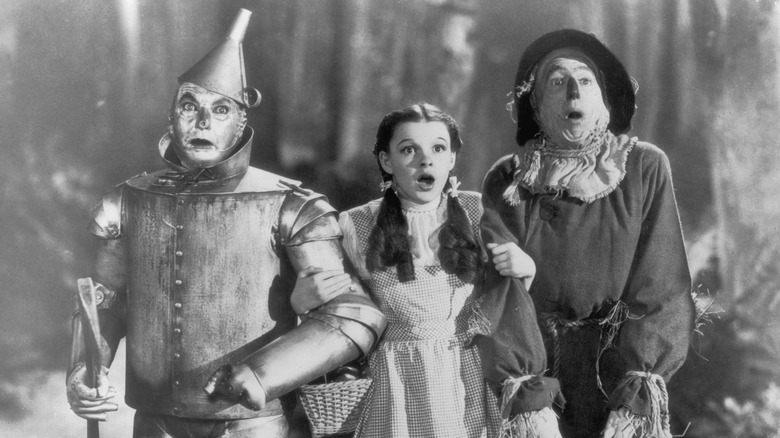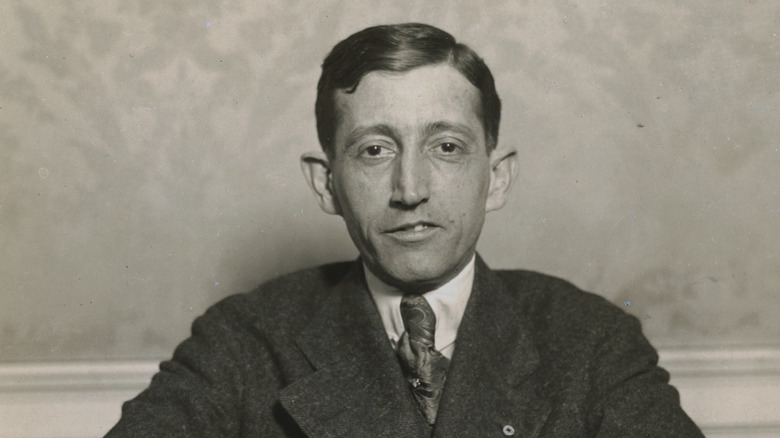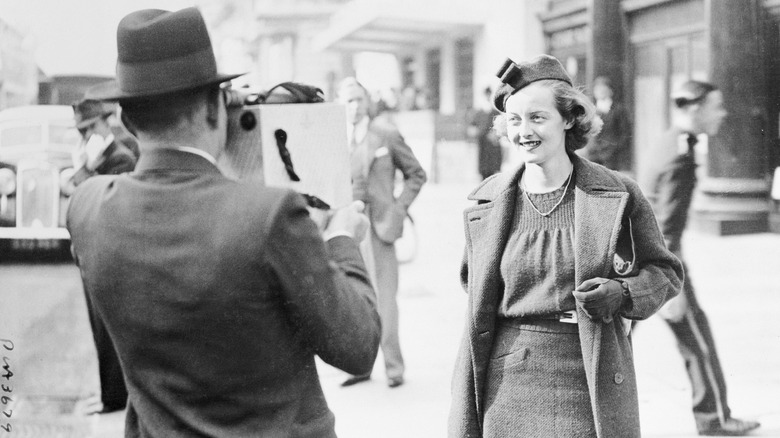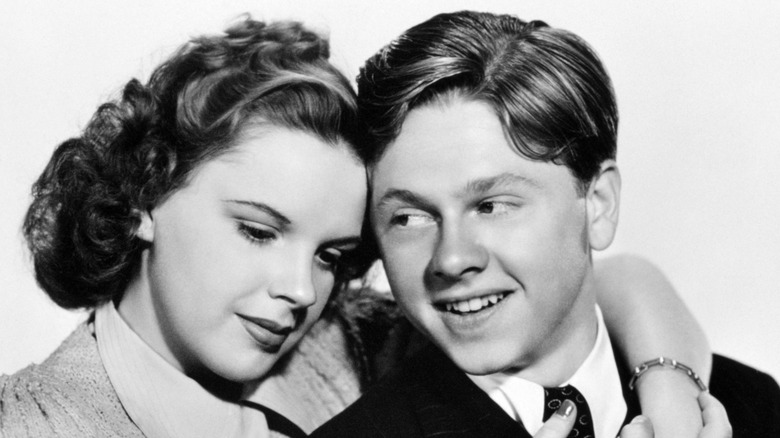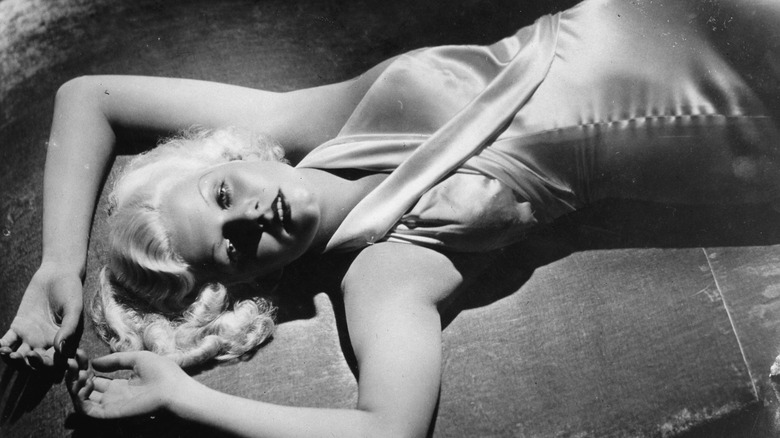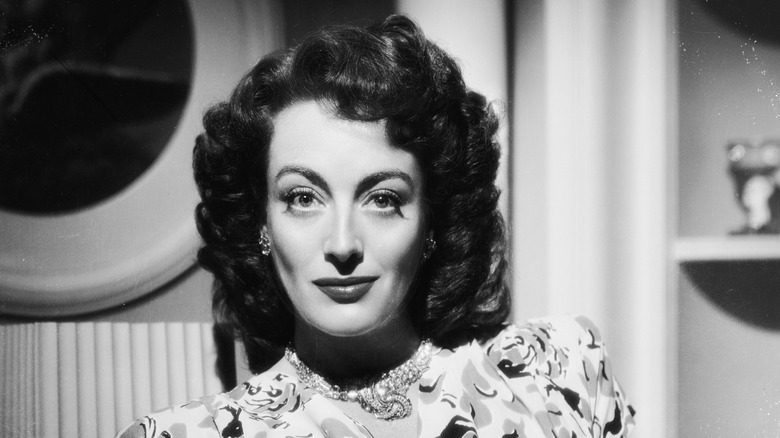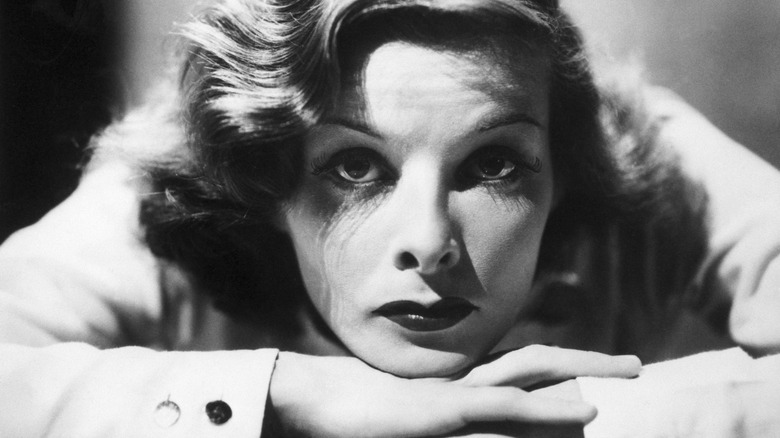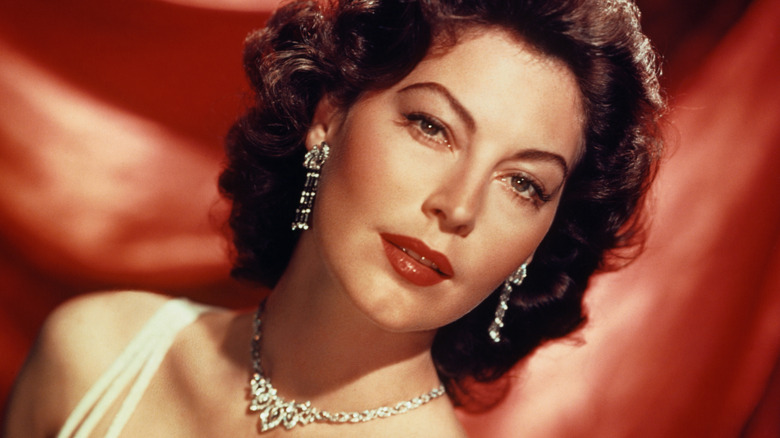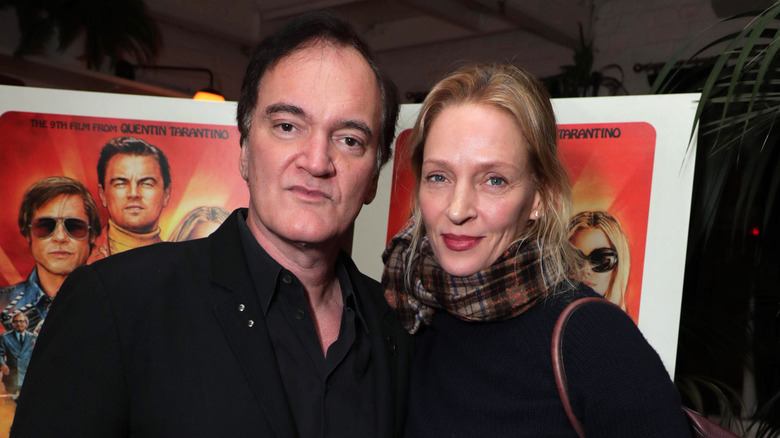The Weirdest Rules Actors Ever Had To Follow
Being a Hollywood actor is many people's idea of a dream job. Acting is a creative field, and if you make it big in the world of cinema it can mean months away shooting in exotic locations, working with the crème de la crème of filmmaking talent, and, if everything goes to plan, being rewarded with healthy box office receipts, critical praise, popular acclaim, and a shelf full of prestigious awards. It also means a life of luxury, with swanky dressing rooms, personal assistants, and more money than you know what to do with.
But starring in Hollywood productions isn't always the fun it's made out to be. Shooting schedules can be arduous, with reports emerging about how the pressure of making Hollywood films can impact actors' mental health. And acting isn't all about delivering dialogue and convincing body language — throughout the sometimes-dark history of the film industry, directors, producers, and studio owners have made huge demands of their actors, even their most famous stars, many of which were weirdly invasive or exploitative. Here are some of the weirdest rules actors have had to follow, from the early days of motion pictures to the present day.
No sharing beds onscreen
Today, it is assumed that filmmakers have the freedom to make their films as true to life as possible. Rather than censor works outright, in the case of movies containing adult themes, they are given a restricted classification rating. However, this hasn't always been the case.
In the 1930s, Hollywood studios found themselves under pressure from conservative activists such as the lobbying group the National Legion of Decency to censor movies in a way that fell in line with a Catholic moral worldview. The result was the Hays Code, named after Motion Picture Producers and Distributors of America president William Hayes (pictured), who decided that rather than reach the point at which filmmakers were subject to outside regulation, they would essentially self-censor and instill a series of rules governing Hollywood studios. In the years that followed, filmmakers were compelled to limit depictions of sex and violence, and to venerate social institutions such as marriage.
However, even depictions of marriage were rendered sexless on screen. For many years, actors portraying married couples were often shown sleeping in twin beds rather than a double, a tradition that continued until the Hays Code was phased out in the 1960s as social change saw the emergence of audiences more attuned to liberal forms of filmmaking.
No 'lustful' scenes
Just like in the worlds of literature and theater, from the early days of cinema, moviegoers have always been smitten with a good love story. However, for the best part of three decades the Hays Code prevented the portrayal of "lustful" behavior onscreen, meaning even love scenes that would appear laughably tame compared to what you'd see today on Netflix were made even more wooden by the studio censors.
For a start, embraces between love interests were heavily regulated. Kisses were performed with minimal movement between the actors, who would hold each other in neutral parts of the body such as the arms or above the midriff. Once the leading man's lips locked onto those of the leading woman, the kiss was allowed to last for a maximum of three seconds, otherwise it would be in violation of the Hays Code. One notable exception was Alfred Hitchcock's 1946 classic "Notorious," in which the director bypassed the code by having actors Cary Grant and Ingrid Bergman engage in multiple small kisses as they held each other.
The code also stipulated that actors should not be shown lying horizontally together in love scenes, as it was thought the effect would be too sexual. This resulted in the infamous "feet on the floor" rule, in which if one actor was to be lying down, the other, usually the man, had to keep their feet on the floor so they could tell the censors they were technically standing.
Actors couldn't turn down parts
But it wasn't just censors that controlled how actors came across to the moviegoing public. Back in the Golden Age of cinema, movie studios were all-powerful, with the money and clout to both make stars and break them. Much of this came from the all-encompassing contracts that screen actors were made to sign if they wanted to work with a specific studio. Such contracts typically had exclusivity clauses, preventing actors from working with other studios, although studios would occasionally loan out talent in the same way a sports team might do if someone on the roster is deemed surplus to requirements.
But early movie studio contracts also typically stipulated that actors on their roster had to take whatever parts were offered to them, whether they liked the part or not. The movie icon Bette Davis, best known for her roles in Oscar-winning movies such as "All About Eve" and "Whatever Happened to Baby Jane?" caused a scandal within the industry when she turned down roles handed to her by Warner Bros., resulting in the studio taking the actress to court.
The power that studios had in the early days could sometimes be used against their actors for nefarious purposes. One notorious incident involved the once-lauded actor John Gilbert, who after a falling out with his studio was rumored to have been fed work in a series of poor productions that irreparably tarnished his reputation among the viewing public and tanked his career.
Studios arranged actors' love lives
It's no great revelation that Hollywood superstars have public relations teams behind them to help maintain their image and positioning in the cultural firmament. However, the extremes to which studios were once able to manipulate the private lives of their actors would cause a major scandal were it to happen today.
Take, for example, the relationship between Mickey Rooney and Judy Garland. The two starred together in several movies from the mid-1930s onward, and were heavily marketed as dating in real life by MGM Studios. Little did fans know that while Rooney was developing a reputation for being one of the movie industry's most habitual womanizers, Garland was one of the few co-stars he reportedly had no romantic interest in whatsoever — a fact that was heartbreaking to Garland, who was said to be in love with Rooney. Later, Rooney informed Louis B. Mayer, the head of MGM, that he planned to marry Ava Gardner. Mayer was furious, and commanded his leading actor to call the wedding off. "This is my life," Rooney retorted, to which Mayer replied: "It's not your life. Not as long as you're working for me." In the end, the marriage went ahead, though Rooney's infidelities ensured it did not last long.
In other cases, studios made their leading lights enter into sham marriages for the sake of maintaining an image acceptable to their audiences. One of these was Rock Hudson, whose homosexuality was masked from his fans by his marriage to actress Phyllis Gates. The two were married in 1955, a sham that Hudson undertook at the behest of his agent. They divorced three years later.
Exploitative Hollywood contract clauses
Many people concerned with what is today described as the "culture wars" would have you believe that the idea that actors could be canceled because of their opinions or private lives is a 21st century development, a time of heightened sensitivity to bad behavior. However, actors have been judged by their actions offscreen since the early days of cinema, a fact that was reflected in the contracts many of the leading actors of the day signed with Hollywood studios.
As discussed in Eve Golden's "Platinum Girl: The Life and Legends of Jean Harlow," contracts for studios' "featured players," such as Harlow herself, were especially controlling, with a "morals clause" which stipulated that a contract was void if the actor in question ever did anything in public that could be seen to "degrade her in society or bring her into public hatred, contempt, scorn, or ridicule." It might be argued that such clauses were prudent — we can all think of recent movies and TV shows that have bombed spectacularly after one of their leading actors committed a particularly heinous public gaffe. But early Hollywood contracts would often go much further than that; in Harlow's case, her contract stipulated that she would also be let go without compensation if any physical changes to her body, including illness or facial injuries, might damage her bombshell appeal for more than two weeks.
Studios chose actresses' stage names
Like rappers, gamers, and other entertainers, actors often adopt a stage name early in their careers. There are several reasons they might do so. Perhaps another actor has already taken their name and they wish to avoid any confusion; indeed, in some countries such as the U.K., where the acting industry union Equity holds a great deal of sway, actors are unable to share the same name, and in the case of duplicates a new name must be chosen. In other cases, actors may feel that their names are too bland, too common, or do not accurately represent the image of themselves they wish to convey, so they take a stage name to further their personal brand.
Many of cinema's greatest names are, in fact, not the actor's name at all. Marilyn Monroe was born Norma Jeane Mortenson. Rita Hayworth was Margarita Carmen Cansino. And Judy Garland was actually named Frances Ethel Gumm.
Another famous stage name from the Golden Age of Hollywood is Joan Crawford, though her real name was Lucille LeSueur (later changed to Billie Cassin by her stepfather). Bizarrely, when she was first given a movie contract by MGM's Louis B. Mayer, the studio held a $1,000 public contest to select a new name for their latest starlet. "Joan Crawford" was the winning entry, much to the horror of the actress herself, who hated the name but found herself stuck with it for life.
Wardrobe restrictions
As this article has already made clear, early Hollywood studios had a ridiculous amount of control over the lives of some of the most timeless stars to ever grace the silver screen. With actors prized for their preternatural beauty and on-screen charm, they were expected to recreate the grace they showed during their performances in their everyday lives — at least as far the public were aware.
Expectations concerning gender were especially high during the early years of Hollywood: Men were expected to be manly, charming, and gentlemanly, while women were expected to be feminine, graceful, and passive. The gender binary was so strong that some studio costume departments prevented actresses from wearing pants, as they believed that it was more appropriate for women to wear skirts and dresses.
However, some stars railed against the rules they had to abide by. One of these was Katharine Hepburn, whose on-set behavior and willingness to challenge her studio bosses is well documented. In one famous incident, the costume department at her studio confiscated her slacks. In protest, she walked around the studio in just her underwear from the waist down until the garment was returned to her.
Actresses could be forced to keep weight off -- or on
In most forms of work, it would be illegal for employers to hire or fire based on body type, or have any say in their employees' weight whatsoever. But since the early days of the movie industry, studios have routinely kept a close handle on the size and shape of their star assets — and have gone to some underhanded lengths to ensure actors maintain the look the studios want.
As early as the 1930s, huge international stars such as Marlene Dietrich were being pressured to lose weight by their studio bosses. For her role in the pre-Code classic "Morocco," released in 1931, the 5-foot-5 Dietrich dropped from 145 pounds to 130 at the behest of director Josef von Sternberg, who for many years was given the majority of the credit for instilling the German actress with star power. But not all Hollywood weight loss is achieved through diet and exercise. Notoriously, Judy Garland was forced to regularly take amphetamine diet pills to maintain her slight figure, to which she became addicted. Garland died tragically of an overdose of barbiturates in 1969, aged just 47.
Weight control within Hollywood is not a thing of the past. As the comedy actress Rebel Wilson revealed, in the 2010s she had to delay a health plan, which included weight loss, for several years as she was contractually obligated to maintain her weight for the filming of two sequels to the 2012 comedy "Pitch Perfect," in which she played "Fat Amy," which were released in 2015 and 2017.
Studios controlled actresses' family planning
Forcing actors to keep weight off with the use of addictive and ultimately damaging drugs isn't the only way in which Hollywood studios have historically controlled their actresses' bodies. Just as executives would often tend to have a say in whether their actors married or not, on many occasions they have also sought to have the final say over whether the talent on their rosters were allowed to have children.
Such rules were of course about money, with studios concerned that pregnancies would affect shooting schedules, and that their lithe bombshell leads may not maintain the body shapes that they believed made them such a hit on screen. But here's where things take a dark turn. Not only were actresses pressured not to become pregnant, but if they did, they were often then forced to have abortions to terminate the pregnancy. Some of the Golden Age's biggest names secretly had abortions for what they were told was the sake of their careers, including Judy Garland, Joan Crawford, Bette Davis, and Ava Gardner (pictured). Indeed, as with other aspects of their lives, the very contracts many stars signed with their studios often contained clauses outlining punishments for becoming pregnant while under contract.
Strange demands of leading actors
But while stars of the silver screen have often found themselves having to follow the rules of studios, executives, directors, and producers, oftentimes actors have had to pander to the strange demands of their co-stars. This is particularly the case when actors are starting out and considered a secondary concern for the production or, at the very first, dispensable.
The "Fantastic Four" and "Sin City" actress Jessica Alba eventually became one of Hollywood's biggest box office draws, but in the early years of her acting career even she found herself having to toe the line and abide by one of the industry's most notorious directives: the no eye-contact rule. A long-held rumor attached down the years to various stars including Sandra Bullock and Leonardo DiCaprio, it stipulates that other actors are banned from making eye contact with the big name. Alba has claimed that she was forced to abide by it on the set of "Beverly Hills 90210" back in 1998, when she was instructed not to make eye contact with the show's major stars, including Luke Perry and Tori Spelling.
Other rumors of strange rules attached to individual actors include one imposed by "Mission: Impossible" stalwart Tom Cruise. For many years, Cruise, who is known for his action movie stunts and athletics on screen, would only ever be filmed sprinting solo with no other actors running alongside him. The rule was only broken in 2017 with the release of "The Mummy," for which his co-star Annabelle Wallis was able to convince Cruise that she had the running abilities to keep up with him.
Being put in physical harm
Only a handful of specialized jobs, such as those attached to the military or security, would require people to put themselves in harm's way for the sake of their paycheck. But in Hollywood, actors have repeatedly put their safety on the line in the service of a picture, often without a stunt double to pitch in.
Some of the early examples are obvious: the crazy stunts from silent movies performed performed by stars like Buster Keaton, whose prowess at seemingly defying death in front of the camera was legendary. Elsewhere, actors have been asked to perform action sequences in circumstances that were later unfortunately proven to be dangerous. In 1982, a freak accident occurred on the set of the "Twilight Zone" movie when veteran actor Vic Morrow was required to carry two child actors across a Vietnam War scene involving real helicopters. When one lost control, all three actors were tragically killed by the aircraft's rotating blades.
More recently, actress Uma Thurman has spoken about one unfortunate incident involving one of her closest collaborators, "Pulp Fiction" director Quentin Tarantino. Thurman suffered serious injuries on the set of "Kill Bill," when she was forced to take part in an on-screen automobile crash in which the actress suffered neck and knee injuries. She has claimed that she was coerced into shooting the scene, and that producers then took part in a cover-up. Tarantino has since apologized and claims he deeply regrets the incident.
